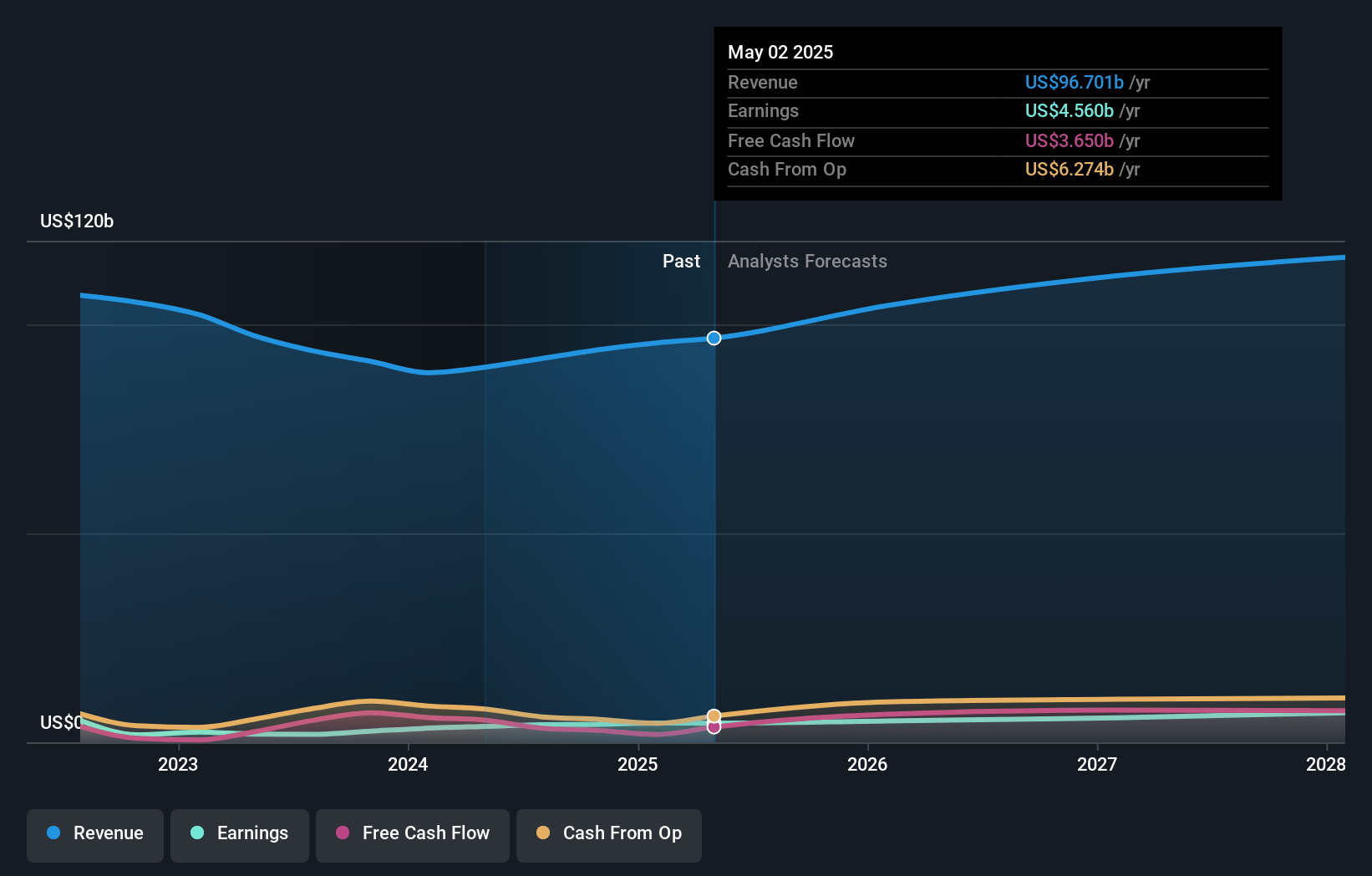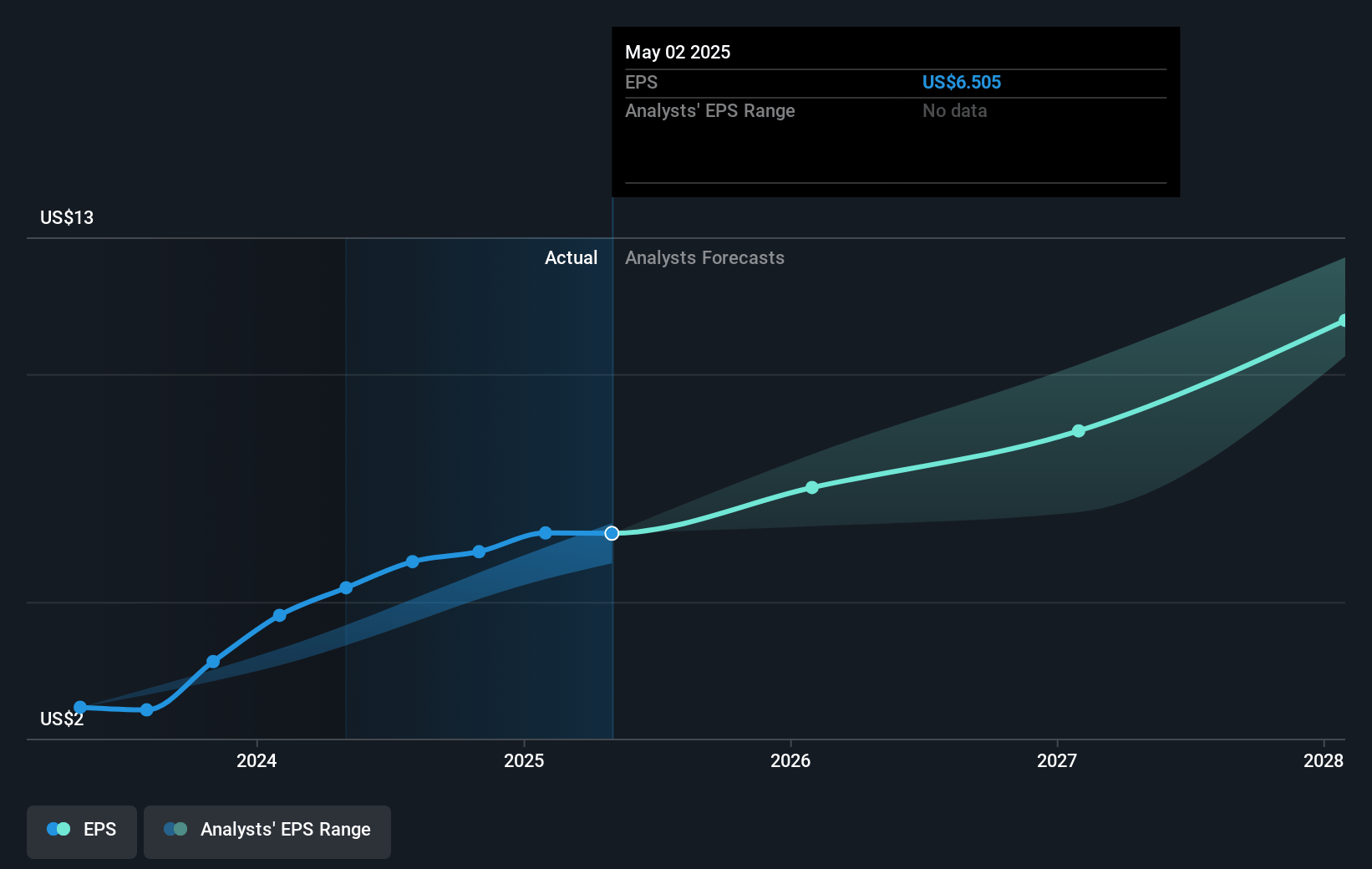Last Update07 May 25Fair value Decreased 15%
Key Takeaways
- Strong AI server demand boosts sales but dilutes overall gross margins due to increased AI server mix.
- Competitor pressures and aggressive pricing in the Consumer and Small Business segment threaten revenue and earnings growth.
- Competitive pricing and increased market pressures could hinder Dell's profitability and growth, exacerbated by trade issues, lower free cash flow, and demand challenges.
Catalysts
About Dell Technologies- Designs, develops, manufactures, markets, sells, and supports various comprehensive and integrated solutions, products, and services in the Americas, Europe, the Middle East, Asia, and internationally.
- Dell Technologies is experiencing robust demand for AI servers, with a projected increase of at least 50% to reach $15 billion in AI server shipments. However, the margins for AI servers are expected to be dilutive, impacting overall gross margins as a higher mix of AI-optimized servers becomes prevalent.
- Despite operating expenses being reduced by 4%, there is ongoing competition, especially in the Consumer and Small Business (CSG) segment, which poses challenges to revenue and net margins due to aggressive pricing pressures in the market. This could lead to a slower-than-expected growth in their most profitable segments, affecting earnings.
- The company's significant backlog in AI orders indicates strong demand, yet there may be potential challenges in execution and delivery of these orders, affecting future earnings and revenue growth rates if supply chain or other operational hurdles arise.
- The modernization and transformation efforts, which include automating operations and increasing AI utilization within their processes, aim to drive long-term efficiency and lower operational expenses. However, if these do not yield the anticipated efficiencies, they could impact margins and require additional investment.
- Dell's exposure to external factors, such as tariffs and regulatory changes in key markets like China, could affect input costs and force price adjustments that might not be transferable to the customer, potentially impacting net income and cash flow projections.
Dell Technologies Future Earnings and Revenue Growth
Assumptions
How have these above catalysts been quantified?- This narrative explores a more pessimistic perspective on Dell Technologies compared to the consensus, based on a Fair Value that aligns with the bearish cohort of analysts.
- The bearish analysts are assuming Dell Technologies's revenue will grow by 4.6% annually over the next 3 years.
- The bearish analysts assume that profit margins will increase from 4.8% today to 5.6% in 3 years time.
- The bearish analysts expect earnings to reach $6.2 billion (and earnings per share of $9.46) by about May 2028, up from $4.6 billion today. The analysts are largely in agreement about this estimate.
- In order for the above numbers to justify the price target of the more bearish analyst cohort, the company would need to trade at a PE ratio of 12.4x on those 2028 earnings, down from 14.6x today. This future PE is lower than the current PE for the US Tech industry at 12.6x.
- Analysts expect the number of shares outstanding to decline by 1.62% per year for the next 3 years.
- To value all of this in today's terms, we will use a discount rate of 8.88%, as per the Simply Wall St company report.
Dell Technologies Future Earnings Per Share Growth
Risks
What could happen that would invalidate this narrative?- The competitive pricing environment, particularly in the Client Solutions Group, is impacting gross margin, which could pressure profitability and net margins in the future.
- Increased competition in the AI server market, especially from Original Design Manufacturers and other OEMs, could lead to margin pressure, affecting both revenue growth and profitability.
- The consumer segment within the Client Solutions Group is experiencing softness in demand and profitability issues, which could impact both revenues and net margins if the trend continues.
- Potential changes in tariff regulations and global trade dynamics, especially involving China, could lead to increased input costs. This would adversely affect Dell's cost structure and squeeze net margins.
- The company's free cash flow was notably lower compared to the previous year, partly due to higher inventory investments. If this doesn't improve, it could limit Dell's ability to reinvest in growth areas or return capital to shareholders.
Valuation
How have all the factors above been brought together to estimate a fair value?- The assumed bearish price target for Dell Technologies is $89.0, which represents the lowest price target estimate amongst analysts. This valuation is based on what can be assumed as the expectations of Dell Technologies's future earnings growth, profit margins and other risk factors from analysts on the more bearish end of the spectrum.
- However, there is a degree of disagreement amongst analysts, with the most bullish reporting a price target of $170.0, and the most bearish reporting a price target of just $89.0.
- In order for you to agree with the bearish analysts, you'd need to believe that by 2028, revenues will be $109.4 billion, earnings will come to $6.2 billion, and it would be trading on a PE ratio of 12.4x, assuming you use a discount rate of 8.9%.
- Given the current share price of $95.79, the bearish analyst price target of $89.0 is 7.6% lower. Despite analysts expecting the underlying buisness to improve, they seem to believe the market's expectations are too high.
- We always encourage you to reach your own conclusions though. So sense check these analyst numbers against your own assumptions and expectations based on your understanding of the business and what you believe is probable.
How well do narratives help inform your perspective?
Disclaimer
AnalystLowTarget is a tool utilizing a Large Language Model (LLM) that ingests data on consensus price targets, forecasted revenue and earnings figures, as well as the transcripts of earnings calls to produce qualitative analysis. The narratives produced by AnalystLowTarget are general in nature and are based solely on analyst data and publicly-available material published by the respective companies. These scenarios are not indicative of the company's future performance and are exploratory in nature. Simply Wall St has no position in the company(s) mentioned. Simply Wall St may provide the securities issuer or related entities with website advertising services for a fee, on an arm's length basis. These relationships have no impact on the way we conduct our business, the content we host, or how our content is served to users. The price targets and estimates used are consensus data, and do not constitute a recommendation to buy or sell any stock, and they do not take account of your objectives, or your financial situation. Note that AnalystLowTarget's analysis may not factor in the latest price-sensitive company announcements or qualitative material.











